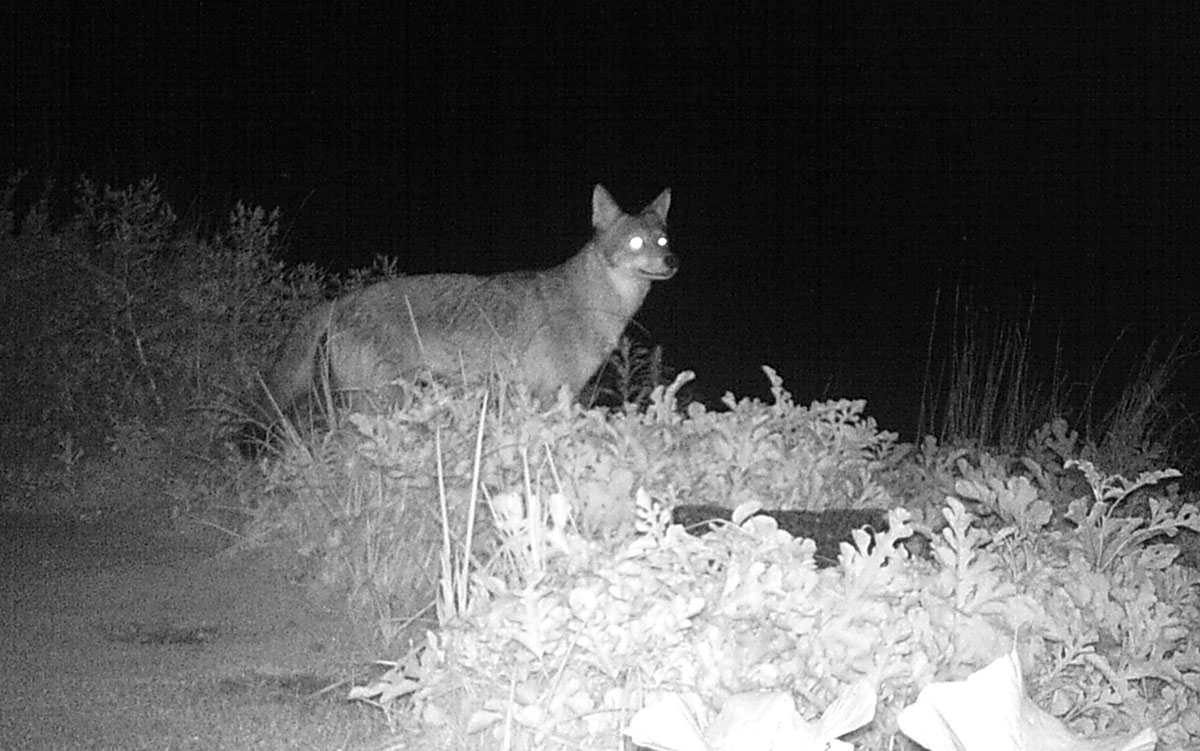Nature Notes:
Predators of Fishers Island
by Terry McNamara
The term ‘predator’ may bring to mind images of a muscled mountain lion ready to pounce in an isolated gully or a muddied crocodile lying in wait at a quiet Saharan watering hole. You might even think that predators are reserved for exotic jungles or swamps. However, Fishers Island hosts its own murderer’s row of predators, no less fascinating though decidedly less threatening (to humans, at least), and they each have a vital role in keeping the island’s ecosystem healthy, diverse and robust. This article will highlight several standout predators in the Fishers Island ecosystem in the hopes that you come away with a deeper respect and appreciation for them, especially if you are lucky enough to have a face-to-face meeting.
Fishers Island has a very diverse population of animal life found across a variety of different wooded habitats and grasslands, extensive marine coastline, sheltered coves and 130 acres of fresh and brackish ponds. You’ll find small mammals, birds, frogs, turtles, snakes, fish, insects, and other invertebrates across the entire island.
Each of these populations, predator and prey, is constrained in size by several factors; however, the key factor is the island’s 4.2 square mile area. The size of the habitat limits the maximum number of any species that can be supported nutritionally. For example, mainland studies indicate that the minimum acreage of healthy forest needed to support a fisher cat is approximately 10 square miles. Although island ecology often differs, this suggests that any fisher cat that visits the island will be transient.
Red-tailed Hawk carrying off mink prey from HHC Golf Course, August 2018. Photo by Tommy Colman.
The population densities of prey are directly related to the food available. The island’s small area is greatly impacted when invasive plants occupy the limited growing space of native edible plants. Additionally, in recent years pesticides and herbicides from lawns and gardens are greatly depressing the populations of insects. While the deleterious effects of these toxins on human health are well documented, they also threaten and weaken the natural systems upon which the island ecosystem survives and wreak havoc on the small birds, shrews, moles, frogs, snakes, salamanders, and spiders that rely on these insects for their basic nutritional needs.
DOMINANT PREDATORS
The coyote and the Great Horned Owl are the two most dominant predators on the island’s 2,600 acres of wooded and grassland areas. There are also a number of minor players like the raccoon, mink, Red-tailed Hawk and Barred Owl who terrorize the local populations of small fauna (and each other). The island’s coastlines and pond shorelines are stalked by ospreys, egrets, herons, snapping turtles, and mink. In addition, there are transients like the River Otter that move through the area.
You are probably most familiar with the island’s diurnal predators, as their hunting activity happens in the bright light of day. However, most predation on the island happens at night, hidden by a cloak of darkness. Coyotes have been in residence on the island for over a dozen years yet they were rarely spotted until quite recently. Their nocturnal habits kept them hidden from view, but the chorus of howls at the noon siren left no doubt about their presence.
The actual numbers of each species that currently call Fishers Island home are difficult to determine. Research gives us a basis for the maximum number that might be supported; that information, coupled with anecdotal accounts of sightings, enable us to make an educated guess.
MAMMALIAN PREDATORS
Coyotes
While the scientific community continues to debate whether humans are (still) apex predators, there is no doubt that while not apex, coyotes are the top predators on Fishers Island. Once fully grown at 40-50 pounds, they have no natural enemies aside from irate pet owners and their proxies. Their diet includes all the smaller fauna residing on Fishers Island as well as a large variety of fruits and vegetables. They consume whatever is available season to season, be it nesting swans in the spring or ripe watermelon in the summer.
Their extreme adaptability with regard to diet allows them to thrive even when their home range is constrained. Studies have shown packs existing within home ranges as small as 100 acres (1/15 of a square mile), however in New York State the range for a pack tends to be slightly more than 2 square miles. Contrary to popular imagination, a pack of coyotes is not like a pack of wolves. Coyotes are generally considered shy and non-confrontational. Although coyotes live in family groups like wolves, they usually travel and hunt alone or in loose pairs.
A coyote pack consists of a breeding pair and usually one or more of their nonbreeding offspring. The younger coyotes, especially the males, are forced to leave when a new breeding season begins. A few female offspring may remain to help raise the next litter, if they fail to breed. Eventually, they strike out on their own looking for an unoccupied territory and sometimes they swim to islands like ours, remaining transient until they have established themselves in an area.
Packs do not aggressively defend their feeding territory except during the denning period (April-June) or in times of food scarcity. There have not been any hostile coyote-human interactions reported on Fishers Island, though coyotes have been responsible for the disappearance of several domestic pets. However, they are not the only suspects. The island’s coyotes are vigorously competing against mink, raccoons, owls, and hawks for prey among the island’s smaller vertebrate populations.
Watermelon-eating coyote in Dave Denison’s HHC garden, 1:53 a.m., August 24, 2018. Wildlife cam photo.
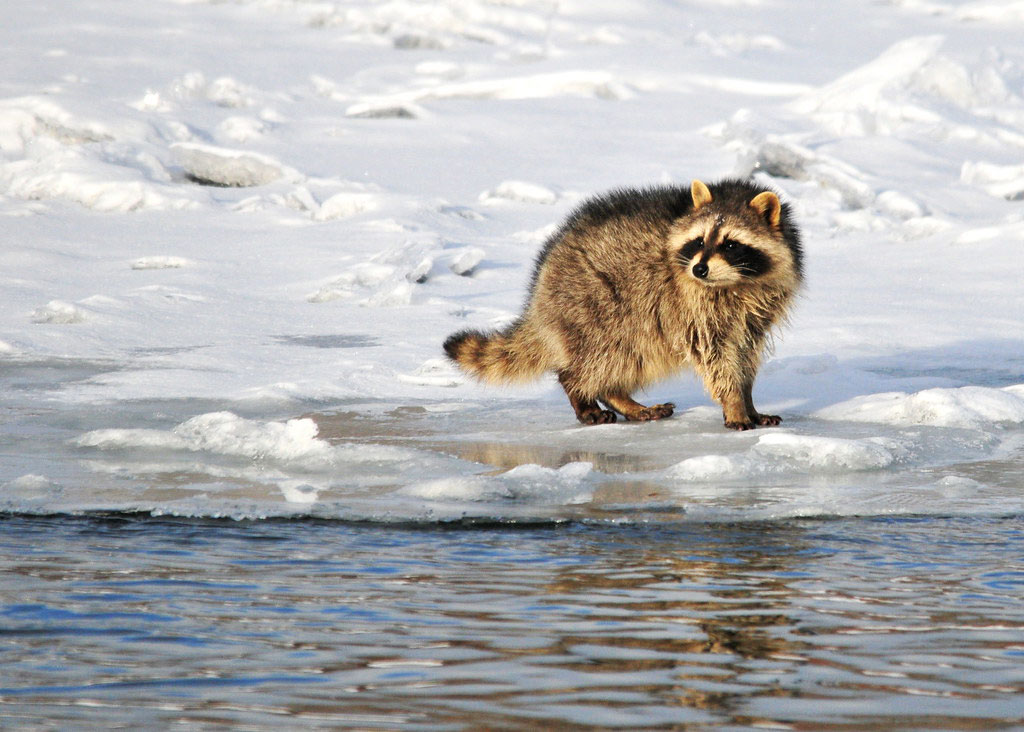
Raccoon. Photo by Tom Koerner, USFWS
Raccoons
The diet of the raccoon, another nocturnal predator, consists mostly of invertebrates, bird eggs, and vegetation. Since raccoons rely on small animals for only a quarter of their dietary needs, a forest can support up to 15 raccoons per acre Beyond their hunting skills, they are very adept at accessing garbage cans for kitchen leftovers. They avoid predation by coyotes, large hawks and owls using their climbing and swimming skills and they avoid areas where coyotes are active. Their longevity is in the 2–3-year range due to their susceptibility to various diseases such as canine distemper, a viral infection that can decimate local populations.
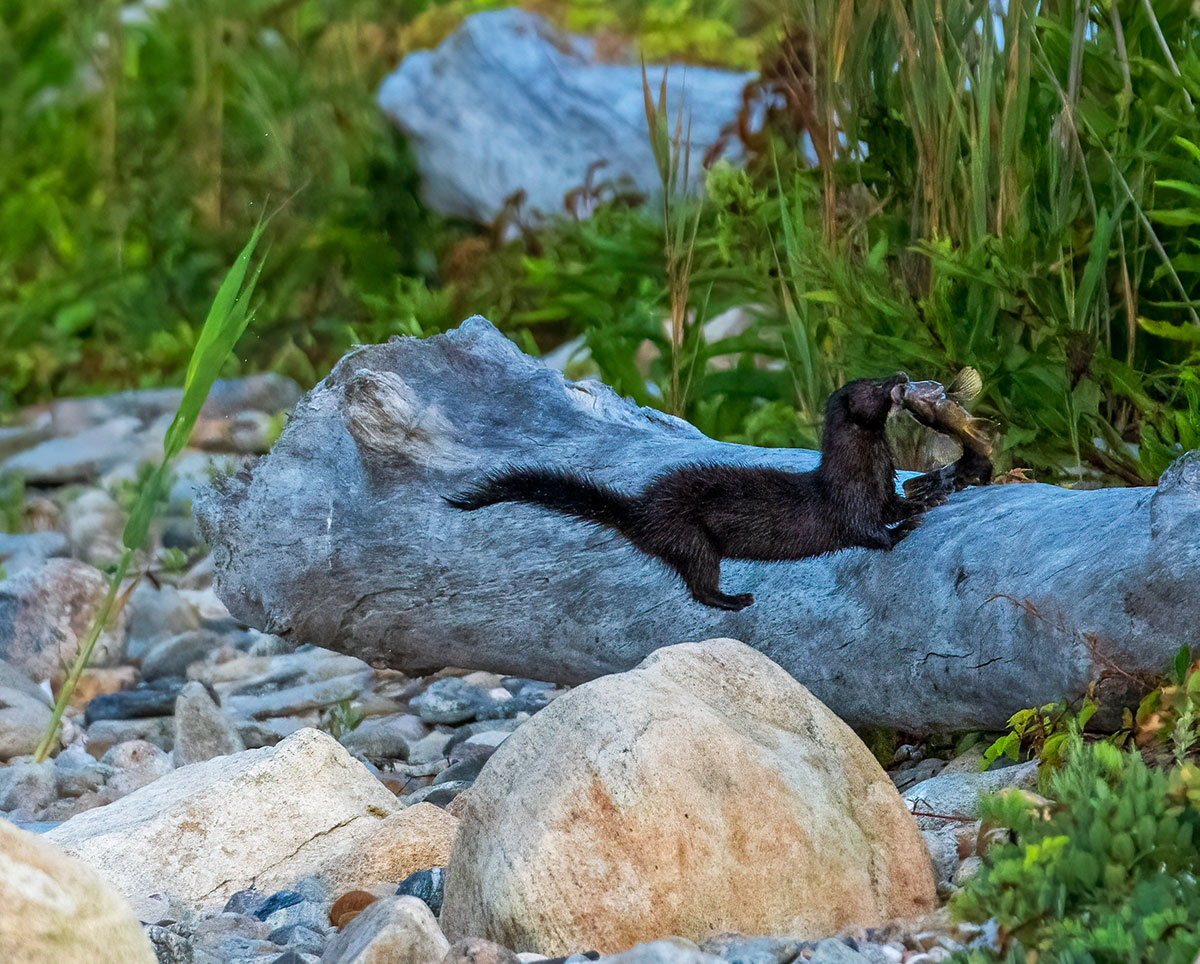
Mink with captured fish, South Beach. Photo by Todd McCormack.
Mink
Perhaps the most successful predator on the island during the past decade has been the mink. They have a voracious appetite and a skill set that enables them to take prey much larger than themselves. Mink are comfortable on land, in trees, and in the water, allowing them to hunt a wide variety of prey. A male will occupy and defend an area of 30 acres or more during his 3-year lifetime.
It is rare to encounter any of these predators, as they are nocturnal by nature. However, prey availability, famine, or disease will alter their innate behavior and cause appearances during daylight hours. The populations of all these animals tend to fluctuate as the prey populations wax and wane. Food availability, weather conditions, and diseases are some of the causes of the cyclic nature of prey population, as well.
AVIAN PREDATORS
Great Horned Owl
The Great Horned Owl is the largest and fiercest of our avian predators with a home range of one-quarter to five square miles. They threaten all but the largest creatures in the woodlands and grasslands, so only adult coyotes, large raccoons, and river otters avoid being considered prey. These owls are most easily located by their calls, nests, and the 3-4 inch long owl “pellets” found beneath their nests and roosts. They feast upon other avian predators, including surprisingly large prey such as Ospreys and Great Blue Herons; however, small mammals seem to be their preferred diet.
Red-tailed Hawk and Barred Owl
Red-tailed Hawks and Barred Owls are predators that can both be observed during the daylight hours, though activitywise the hawks work the day shift and the owls mostly feed late afternoon through dawn. Any moving creature rabbitsized or smaller is fair game. Generally, home ranges for these residents are about one square mile though the larger raptors have hunting areas ranging from 200 yards to over 18 miles from their nesting area.
Sharp-shinned Hawk and Cooper’s Hawk
It is not uncommon to spot the Sharp-shinned Hawk disable smaller birds by slamming into them in mid-air or the larger Cooper’s Hawk barnstorming through shrubbery and hedges while in pursuit of Mourning Doves and other medium-sized birds. They are the hawks most likely to be observed in the vicinity of bird feeders.

Great Horned Owl, circa 1922. Photo by H.L. Ferguson.
Great Blue Heron, Great White Egret, Osprey, Belted Kingfisher and Double-crested Cormorant
Along the island’s marine, pond, and cove shorelines, the Great Blue Heron and Great White Egret are the dominant wading avian predators. Ospreys (whose numbers have been increasing of late) and the Belted Kingfisher hunt fish by plunging dramatically from the air into the water. The Double-crested Cormorant, whose numbers have increased for the same reason as the Ospreys, the banning of the insecticide DDT, feed on fish by pursuing them underwater, propelled by their feet like a prehistoric-looking, matte-black torpedo.
REPTILIAN PREDATORS
Northern Black Racers
Two of my favorite island reptiles round out the predator roster. The Northern Black Racer is the largest snake found on Fishers Island. If you frequently hike in lightly wooded areas or fields, you will probably encounter this handsome glossy black snake as it hunts during the daylight hours. It actively feeds on rodents and other snakes. Though they make themselves comfortable in one area when overwintering through the early spring, the Northern Black Racer’s average home range is approximately 30 acres. They live up to 10 years in the wild, providing a steady check on the island’s rodent population. Do not fear if you encounter one; there are no wild venomous snakes on Fishers Island.
Common Snapping Turtles
The Common Snapping Turtle is one of the longest living predators on the island. It can take a Common Snapping Turtle up to 20 years to reach sexual maturity, and if they are lucky, they can live up to 100 years. Research indicates that an acre of pond area can support a snapping turtle biomass of nearly 200 pounds, which is equal to four or five adults. Adults feed on anything they are able to subdue. This includes small mammals, birds, amphibians, fish, and invertebrates as well as aquatic vegetation. Though they have acquired a reputation for eating ducklings, studies show that this is exaggerated. Ducks and geese have been found to make up less than 1% of their diet.
Built like an amphibious armored tank, the mature turtle is only vulnerable to predation by coyotes when it is on land. This generally occurs during the spring when they are migrating to a more favorable environment, or when the females are nesting. If you should encounter a Common Snapping Turtle crossing the road, it is natural to want to make sure it reaches safety. However, care should be taken as they can be quite fierce when approached. In the water, however, the opposite disposition is on display. Individuals pacifically avoid contact and swim away.
CONCLUSION
The health of Fishers Island’s ecosystem depends on an expansive and complex web of relationships between producers and consumers, predators and prey. To preserve the island’s diverse flora and fauna we must make a concerted effort to increase the amount of acreage that is conserved, to remove invasive plants, and limit pesticide and herbicide use. By protecting and preserving these natural habitats from development, all Fishers Island residents, great and small, benefit.
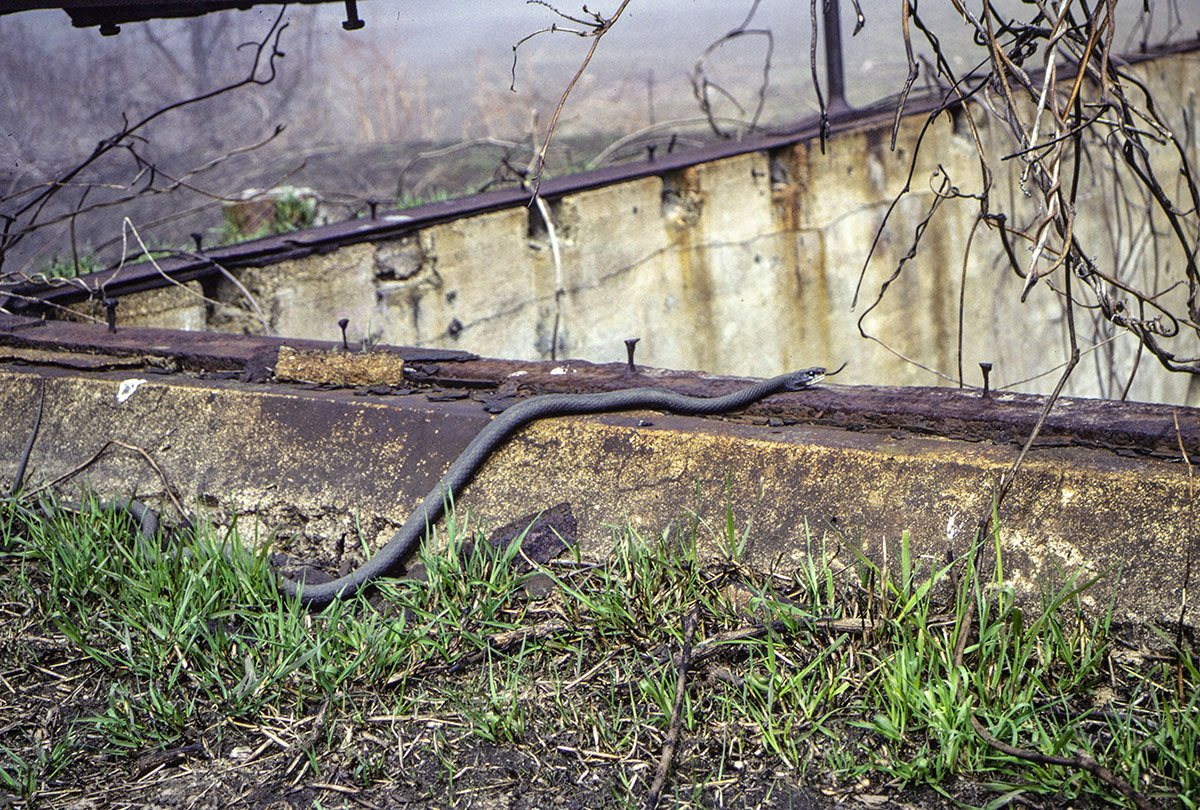
Northern Black Racer snake atop Fort Wright gun emplacement at Parade Grounds. Photo by Jackie Williamson.
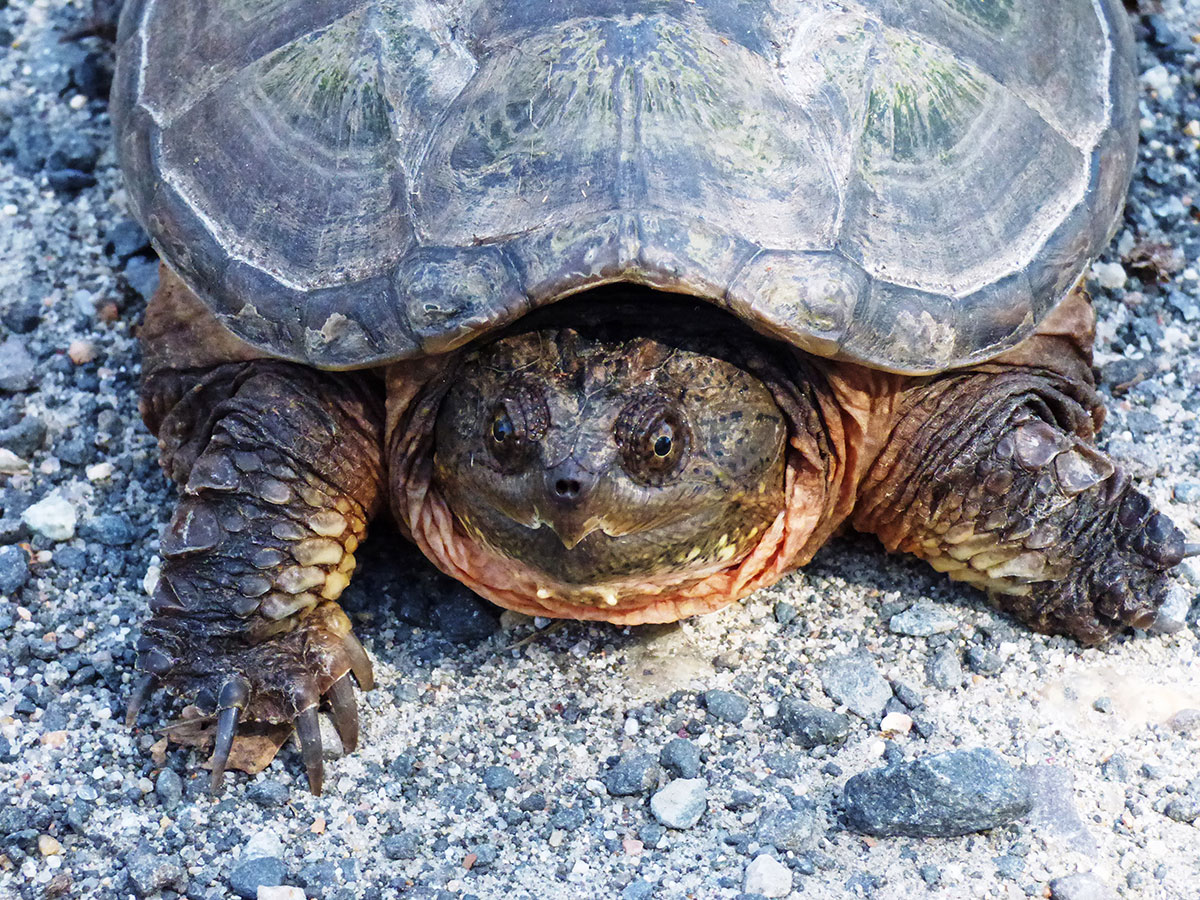
Common Snapping Turtle. Photo by Justine Kibbe.
The Henry L. Ferguson Museum Newsletter Vol. 36, No. 1 • Spring 2021


